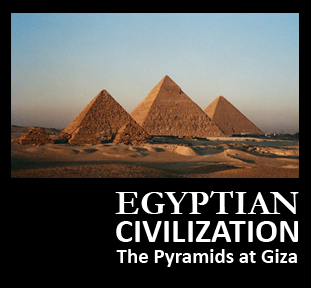
KHUFU, KHAFRE and MENKAURE
hi friends,
Ancient Egypt — a land of mysteries. No other civilization has so captured the imagination of scholars and laypeople alike. Mystery surrounds its origins, its religion and its monumental architecture: colossal temples, pyramids and the enormous Sphinx. The Egyptian pyramids are the most famous of all the ancient monuments, the only remaining wonder of the seven wonders of the ancient world.
Herodotus, a Greek historian who is frequently designated ‘The Father of History,’ went on to call Egypt itself the “Gift of the Nile”, and in doing do he has given us a remarkably accurate summary of Egyptian Civilization.
Just as life arose from the waters, the seeds of civilization were first sown along the banks of the Nile. This mighty river, which flows north from the heart of Africa to the Mediterranean Sea, nourished the growth of the Pharaohs kingdom. The long, narrow flood plain was a magnet for life, attracting people, animals and plants to its banks. In Pre-dynastic times, nomadic hunters settled in the valley and began to grow crops to supplement their food supply. Seen as a gift from the gods, the annual flooding of the river deposited nutrient rich silt over the land, creating ideal conditions for growing wheat, flax and other crops. The first communal project of this fledgling society was the building of irrigation canals for agricultural purposes.
The sun was a principal deity whose passage across the sky represented the eternal cycle of birth, death and rebirth. The pharaohs were seen as gods, divine representatives on earth who, through rituals, ensured the continuation of life. After death, they became immortal, joining the gods in the after-world.
Spinx: The lion with a human head
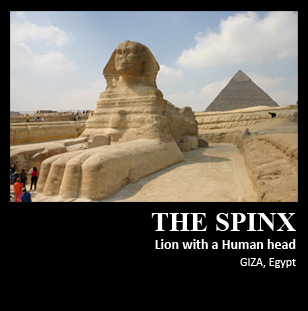
The Egyptian Spinx at GIZA
A Sphinx is a mythological figure which is depicted as a recumbent lion with a human head. It has its origins in sculpted figures of Old Kingdom Egypt, to which the ancient Greeks applied their own name for a female monster, the strangler, an archaic figure of Greek mythology. Similar creatures appear throughout India as Narasimha (The man-lion) and the sphinx enjoyed a major revival in European decorative art from the Renaissance onwards.
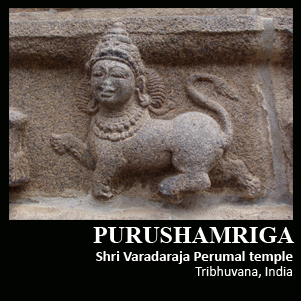
Indian Spinx
The largest, and best known Sphinx lies near the Great Pyramid in the Giza Valley Plateau, situated about six miles west of Cairo. It is the largest single sculpted statue in the world, carved from the bedrock of the plateau. The Sphinx is oriented due east – facing the rising sun – near the 30th parallel – and may well be the oldest monument on the Giza Plateau since long-term water weathering has been found in the great pit in which it lays.
No one is certain when the Sphinx was built nor what it represents, though many theories about its origin and purpose have been noted. It is commonly believed that the Sphinx was built by ancient Egyptians in the 3rd millennium BC.
Carved out of the surrounding limestone bedrock, the Sphinx is 57 metres (260 feet) long, 6 m (20 ft) wide, and has a height of 20 m (65 ft), making it one of the largest single-stone statues in the world. Blocks of stone weighing upwards of 200 tons were quarried in the construction phase to build the adjoining Sphinx Temple.

Greek Spinx
All these cultures and civilizations share the same ideas…..and idols, but with different names.
The true origin and purpose of the Sphinx remains a mystery, and it is perhaps a puzzle which will never be fully solved. Despite its fundamental enigma, the image of the Sphinx remains in the mind of history as the keystone of ancient Egyptian civilization and a part of its religious beliefs.
MUMMY
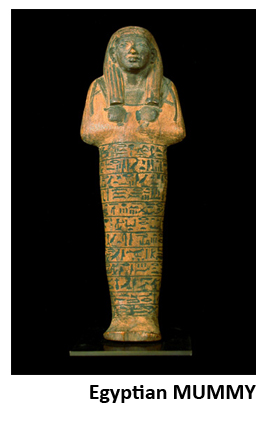
egyptian mummy
Their mastery in mummification is the highlight of their knowledge in Medical Science.
The Egyptians also believed that the body and soul were important to human existence, in life and in death. Their funerary practices, such as mummification and burial in tombs, were designed to assist the deceased find their way in the after-world. The tombs were filled with food, tools, domestic wares, treasures — all the necessities of life — to ensure the soul’s return to the body so that the deceased would live happily ever after.
The most imposing tombs are the famous pyramids, shaped like the sacred mound where the gods first appeared in the creation story. These were incredibly ambitious projects, the largest structures ever built. Their construction was overseen by highly skilled architects and engineers. Paid laborers moved the massive limestone blocks without the use of wheels, horses or iron tools. The conscripts may have been motivated by a deep faith in the divinity of their leaders and a belief in immortality. Perhaps they thought that their contributions would improve their own prospects at the final judgment in the after-world.

Bastet
Cats were treated as Gods in Egyptian Era. Recent discoveries prove that cats become domesticated during this period, in modern day TURKEY
.
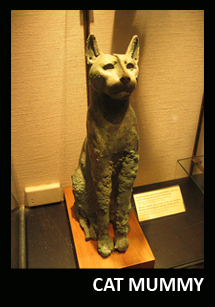
mummyfied cat
They loved, cared and worshiped cats more than any other civilization.
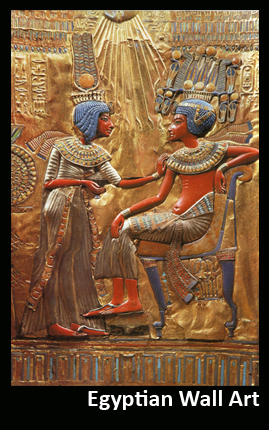
egyptian art
The Egyptian art is the most developed one when compared to other civilizations.
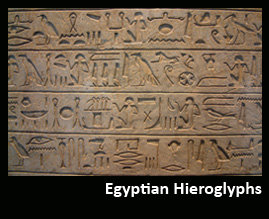
pictorial language
Without the Hieroglyphs (pictorial language) modern day Archeologists won’t have ever come this much close to know the Egyptian Civilization.
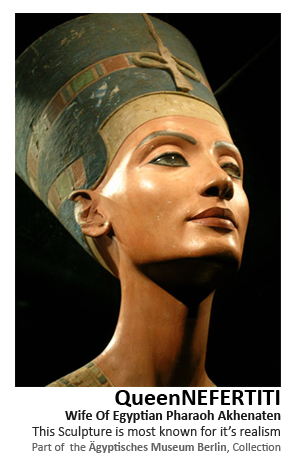
Nefertiti
Nefertiti and her husband were known for changing Egypt’s religion from a polytheistic religion to a henotheistic religion. They revered only one god, Aten, the sun disc. This was not strictly monotheism, as they did not deny the existence of other gods.
She had many titles: read Heiress, Great of Favors, Possessed of Charm, Exuding Happiness, Mistress of Sweetness, beloved one, soothing the king’s heart in his house, soft-spoken in all, Mistress of Upper and Lower Egypt, Great King’s Wife, whom he loves, Lady of the Two Lands, Nefertiti’.

became pharaoh at 9 and reigned for 10 years
Tutankhamun, named Tutankhaten early in his life, was the 12th Pharaoh of the Eighteenth dynasty of Egypt. He ruled from 1334-1323 BC and lived ca. 1341 BC – 1323 BC, during the period known as the New Kingdom. His original name, Tutankhaten, meant “Living Image of Aten”, while Tutankhamun meant “Living Image of Amun”.
As Tutankhamun began his reign at age 9, a considerable responsibility for his reign must also be assigned to his vizier and eventual successor, Ay. Nonetheless, Tutankhamun is in modern times the most famous of the Pharaohs, and the only one to have a nickname in popular culture (“King Tut”).
The 1922 discovery by Howard Carter of his (nearly) intact tomb received worldwide press coverage and sparked a renewed public interest in Ancient Egypt, of which Tutankhamun remains the popular face.
In historical terms, Tutankhamun is of only moderate significance, primarily as a figure managing the beginning of the transition from the heretical Atenism of his predecessor Akhenaten back to the familiar Egyptian religion.
The gigantic pyramids were conspicuous targets for tomb robbers, whose plundering jeopardized the hope for eternal life. Subsequent generations of kings hid their tombs in the Valley of the Kings in an attempt to elude the robbers. In the desert valley near the ancient capital of Thebes, now called Lu-xor, they prepared their royal tombs by cutting into the side of the mountain. Despite efforts to hide the entrances, thieves managed to find the tombs, pillaging and emptying them of their treasures.
One tomb was spared, however: Tutankhamun’s. Although his resting place was disturbed twice by robbers, the entrance was resealed and remained hidden for over 3,000 years. Its discovery by the British archaeologist Howard Carter in 1922 is considered the greatest archaeological find in history. Carter spent the rest of his life working on the tomb, removing its treasures to Cairo, and documenting and studying its contents, including the pharaoh’s gold coffins and mask. Tutankhamun’s mummy remains in his tomb, the only pharaoh to be left in the Valley of the Kings
The cause of Tutankhamun’s death is unclear, and is still the root of much speculation.
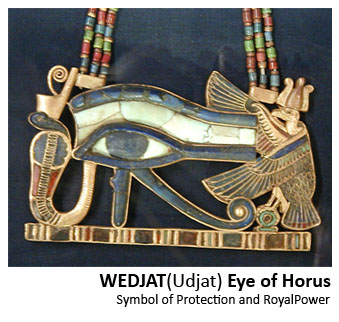
eye of horus
The metaphorical side of this information linked the Old Kingdom six fractions, 1/2, 1/4, 1/8, 1/16, 1/32, and 1/64, to separate parts of the eye, as noted by:
- 1/2 was represented by smell, symbolized by the right side of the eye in a form of the nose. The pyramid text says: “Behold [the fire] rises in Abydos and it comes; I cause it to come, the Eye of Horus. It is set in order upon thy brow, O Osiris Khenti-Amenti; it is set in the shrine and rises on thy brow.”
- 1/4 was represented by sight or the sensation of light, symbolized by the pupil. The pyramid text says: “Perfect is the Eye of Horus. I have delivered the Eye of Horus, the shining one, the ornament of the Eye of Ra, the Father of the Gods.”
- 1/8 was represented by thought, symbolized by the eyebrow. The pyramid text says: “…the Eye of Horus hath made me holy…I will hide myself among you, O ye stars which are imperishable. My brow is the brow of Ra.”
- 1/16 was represented by hearing, symbolized by the left side of the eye in the form of an arrow pointing towards the ear. The pyramid text says: “That which has been shut fast/dead hath been opened by the command of the Eye of Horus, which hath delivered me. Established are the beauties on the forehead of Ra.”
- 1/32 was represented by taste, by the sprouting of wheat or grain from the planted stalk, symbolized by a curved tail. The pyramid text says: “Come, the Eye of Horus hath delivered for me my soul, my ornaments are established on the brow of Ra. Light is on the faces of those who are in the members of Osiris.”
- 1/64 was represented by touch, symbolized by a leg touching the ground, or what can also be thought of as a strong plant growing into the surface of the earth. The pyramid text says: “I shall see the Gods and the Eye of Horus burning with fire before my eyes!”
INFORMATION COURTESY FOR EYES OF HORUS IS FROM WIKIPEDIA

Egyptian Mau
Egyptian Mau’s are a medium-large sized short-haired cat breed. They are the only naturally spotted breed of domesticated cat. The spots on an Egyptian Mau are not only just on the coat; a shaved Mau does, in fact, have spots on its skin. The spotted Mau is an ancient breed from natural stock; its look has not changed significantly as is evidenced by artwork over 3000 years old. Unlike other spotted cats such as Ocicat or Bengal cat the Egyptian Mau is a natural breed. Other breeds are created from domestic breed out-cross or, in the case of the Bengal cat, domestic out-crosses with wildcats. The Mau is significantly smaller than these other breeds.
The Egyptian Mau is the fastest of the domestic cats with its longer hind legs, and unique flap of skin extending from the flank to the back knee, provides for greater agility and with its longer hind legs, and unique flap of skin extending from the flank to the back knee, provides for greater agility and Mau’s have been clocked running over 30 mph (48 km/h).